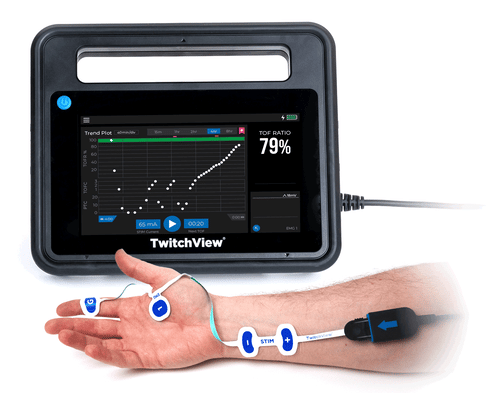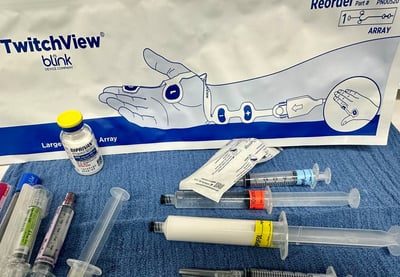Should We Say Goodbye to Neostigmine?
-1.png?width=1080&height=868&name=Untitled%20(10)-1.png)
Key Insights
- Neostigmine has limited efficacy. Reversal is unreliable unless the train-of-four ratio has recovered to approximately 0.4.
- Neostigmine is useful for certain niche applications, such as reversing cisatracurium, which is not reversible by sugammadex.
- If the patient has recovered from neuromuscular block or has not received a neuromuscular blocking drug, neostigmine administration may cause weakness.
Neostigmine is only reliable for reversing shallow neuromuscular blockade
It turns out that neostigmine is not nearly as good as we used to think. With the newer reversal goal of a train-of-four ratio of at least 0.9, reversal with neostigmine will not be successful (within any reasonable time interval) unless the train-of-four ratio is around (at least) 0.4 (“shallow block”). This was demonstrated by Kaufhold et al in a paper from 2016. They showed that neostigmine would not reliably reverse a train-of-four ratio of 0.2 within 10 minutes (after 10 minutes, neostigmine has become fully effective, and we are just waiting for the neuromuscular blocking drug levels to fall due to metabolic or renal clearance) [1]. Previously, Fuchs-Buder et al had shown (in 2010) that neostigmine would reliably reverse a train-of-four ratio of 0.4 within 10 minutes (Figure 1). Thus, it appears that neostigmine is only capable of reliably reversing shallow block, with a train-of-four ratio of at least 0.4 [2].
Also worth noting—there is evidence that neostigmine works much better during total intravenous anesthesia than during inhalation anesthesia—presumably due to the neuromuscular blockade enhancing effects of inhalational anesthetics [3].

Figure 1: The probability of successful reversal starting from a train-of-four ratio of 0.4 and arriving at a train-of-four ratio of 1.0 (using acceleromyography, without normalization) within 10 minutes, plotted against the dose of neostigmine. After Fuchs-Buder et al [2]
Why is neostigmine ineffective at reversing deeper levels of block?
The limited efficacy of neostigmine is easily explained by its mechanism of action. The inhibition of acetylcholinesterase makes more acetylcholine available at the neuromuscular junction to compete for receptor sites with the neuromuscular blocking drug. When acetylcholinesterase is fully inhibited, neostigmine has had its maximum effect. Unfortunately, the additional acetylcholine that is made available will only compete effectively against relatively small amounts of neuromuscular blocking drug (such as during “shallow block”). By contrast, sugammadex is capable of reversing even profound neuromuscular blockade (a post-tetanic count of at least 1—there is no recommended dose of sugammadex for reversing a post-tetanic count of 0, since there is no way to gauge the depth of block when the post-tetanic count is 0).
Is neostigmine still useful?
While neostigmine has a limited role in reversing rocuronium (the most commonly used neuromuscular blocking drug), it does have some niche applications:
- Reversing cisatracurium: Sugammadex reverses aminosteroid neuromuscular blocking drugs only, whereas neostigmine will have reversal activity against any nondepolarizing neuromuscular blocking drug, including cisatracurium (and may reverse persistent succinylcholine block under certain circumstances—more on that in a later post)
- Known allergy: Sugammadex should be avoided in patients with a history of allergy to sugammadex (especially a history of anaphylaxis)
- Interaction with birth control: Women using hormonal birth control are advised in the sugammadex “package insert” to utilize barrier methods of birth control for a period of time after receiving sugammadex, because sugammadex apparently binds contraceptive hormones (although the evidence that this is clinically significant is not readily available).
- Drug shortages: Sugammadex may not be available due to supply chain issues, or due to the choice of a health care facility to avoid sugammadex due to its higher cost compared to neostigmine (given current, typical pricing in the United States—however, sugammadex will be “off patent” soon, which may change the price.)
- History of bradycardia related to sugammadex: Sugammadex might be avoided in patients with a history of severe bradycardia or asystolic cardiac arrest following sugammadex administration. Since the mechanism and incidence of severe bradycardia following sugammadex administration is unknown, it is difficult to know the risk of re-exposure [4]. However, common sense might suggest that re-exposure should be avoided.
- Myasthenia Gravis: Neostigmine makes people with myasthenia gravis stronger—more on that in a later post.
Given these potential applications for neostigmine, “saying goodbye” would seem like a bad idea. However, it is important to understand the limited efficacy of neostigmine. It is not a reliable reversal agent except in the presence of shallow block, with a train-of-four ratio of at least 0.4 (Figure 2).
 Figure 2: Image of the TwitchView2 trend plot following a successful Neostigmine reversal from a TOF Ratio of 40%.
Figure 2: Image of the TwitchView2 trend plot following a successful Neostigmine reversal from a TOF Ratio of 40%.
Should we give sugammadex following neostigmine?
The question occasionally arises, how to manage the situation where neostigmine has been given, but the train-of-four ratio has not reached 0.9. If less than 30 microgram/kg of neostigmine has been given, additional neostigmine could be considered. Alternatively, administration of sugammadex could be considered, assuming there are no contraindications to sugammadex. However, the combination of neostigmine and sugammadex has not been formally studied. Hypothetically, if sugammadex is administered following neostigmine, the weak, intrinsic neuromuscular blocking properties of neostigmine might be “unmasked”—this would be analogous to administering neostigmine to someone who has recovered from neuromuscular blockade, or has not received neuromuscular blocking drugs, which has been shown to produce measurable weakness (Figure 3) [5, 6]. Since the combination of neostigmine and sugammadex has not been carefully studied, the clinical implications are uncertain.
 Figure 3: The response to a series of tetanic stimulations was recorded on a paper strip chart recorder (Payne et al in 1980—yes, 45 years ago!). Neostigmine 2.5 mg restored the normal response to tetanic stimulation and eliminated fade produced by d-tubocurarine (left tracing). However, when an additional dose of neostigmine 2.5 mg was administered, there was a dramatic reduction in the response to a tetanic stimulus and recurrence of dramatic fade, demonstrating that excess neostigmine could actually impair neuromuscular response. After Payne et al [6]
Figure 3: The response to a series of tetanic stimulations was recorded on a paper strip chart recorder (Payne et al in 1980—yes, 45 years ago!). Neostigmine 2.5 mg restored the normal response to tetanic stimulation and eliminated fade produced by d-tubocurarine (left tracing). However, when an additional dose of neostigmine 2.5 mg was administered, there was a dramatic reduction in the response to a tetanic stimulus and recurrence of dramatic fade, demonstrating that excess neostigmine could actually impair neuromuscular response. After Payne et al [6]
There are several acetylcholinesterase inhibitors of interest
Incidentally, neostigmine is not the only acetylcholinesterase inhibitor. There are several others of interest in anesthesia practice. We will get to those later, along with the treatment of myasthenia gravis.


Adapted with permission from Andrew Bowdle MD, PhD, FASE. Originally published on Dr. Bowdle's Substack
A Higher Plane of Anesthesia.
- Kaufhold N, Schaller SJ, Stäuble CG, Baumüller E, Ulm K, Blobner M, Fink H. Sugammadex and neostigmine dose-finding study for reversal of residual neuromuscular block at a train-of-four ratio of 0.2 (SUNDRO20)†, Br J Anaesth. 2016 Feb;116(2):233-40.
- Fuchs-Buder T, Meistelman C, Alla F, Grandjean A, Wuthrich Y, Donati F. Antagonism of low degrees of atracurium-induced neuromuscular blockade: dose-effect relationship for neostigmine. Anesthesiology. 2010 Jan;112(1):34-40.
- Kim KS, Cheong MA, Lee HJ, Lee JM. Tactile assessment for the reversibility of rocuronium-induced neuromuscular blockade during propofol or sevoflurane anesthesia. Anesth Analg. 2004 Oct;99(4):1080-1085.
- Ebert TJ, Cumming CE, Roberts CJ, Anglin MF, Gandhi S, Anderson CJ, Stekiel TA, Gliniecki R, Dugan SM, Abdelrahim MT, Klinewski VB, Sherman K. Characterizing the Heart Rate Effects From Administration of Sugammadex to Reverse Neuromuscular Blockade: An Observational Study in Patients. Anesth Analg. 2022 Oct 1;135(4):807-814.
- Herbstreit F, Zigrahn D, Ochterbeck C, Peters J, Eikermann M. Neostigmine/glycopyrrolate administered after recovery from neuromuscular block increases upper airway collapsibility by decreasing genioglossus muscle activity in response to negative pharyngeal pressure. Anesthesiology. 2010 Dec;113(6):1280-8.
- Payne JP, Hughes R, Al Azawi S. Neuromuscular blockade by neostigmine in anaesthetized man. Br J Anaesth. 1980 Jan;52(1):69-76.



